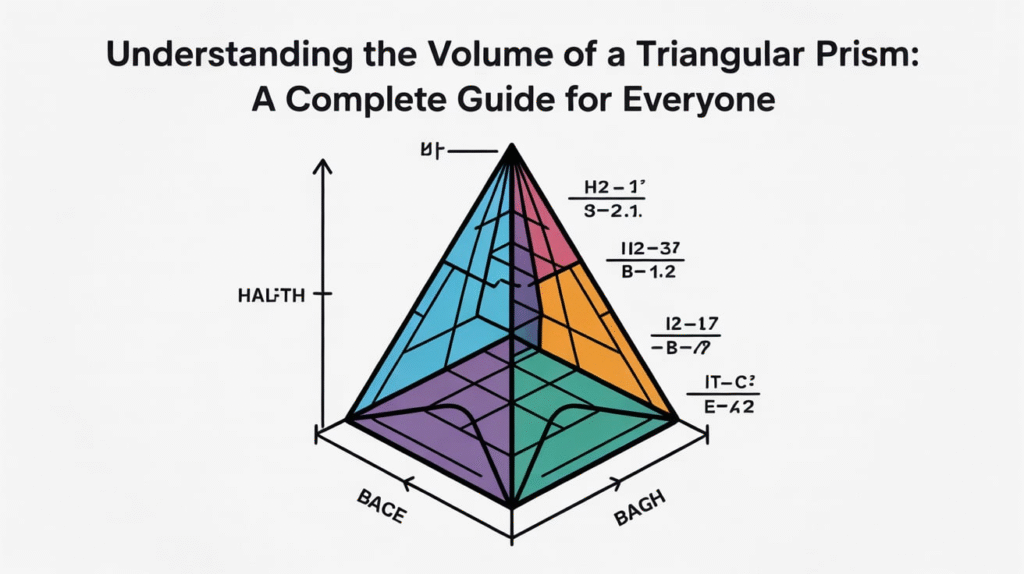Have you ever looked at a tent, a slice of cake, or even a roof and wondered what shape it is? Many of these things have a shape called a triangular prism. It might sound complicated, but it’s actually simple once you understand it.
In this article, we’ll explore everything about the volume of a triangular prism—what it means, how to find it, and why it matters in real life. We’ll take it slow, use easy words, and add fun examples so you can understand the topic clearly.
By the end, you’ll not only know how to find the volume of a triangular prism, but you’ll also see how this idea helps in real-life situations—from building houses to designing packaging. Let’s dive right in!
What Is a Triangular Prism?

A triangular prism is a solid 3D shape that has two triangle-shaped ends and three rectangular sides. Think of it like a box, but instead of squares on the ends, it has triangles.
If you’ve ever gone camping, you’ve probably seen a tent that looks just like a triangular prism. The two ends are triangles, and the sides are rectangles that connect them.
Here’s what makes it special:
- 2 triangular faces (top and bottom)
- 3 rectangular faces (sides)
- 5 faces total
- 9 edges
- 6 vertices (corners)
This shape is common in everyday life, which makes learning about its volume super useful.
What Does “Volume” Mean?
Before finding the volume of a triangular prism, we need to understand what “volume” actually means.
Volume tells us how much space a 3D object takes up inside. It’s like asking, “How much water can fit inside this shape?” The bigger the volume, the more space it fills.
For example:
- A small juice box has a small volume.
- A big water tank has a large volume.
We measure volume in cubic units—like cubic centimeters (cm³) or cubic meters (m³). That’s because we’re measuring 3D space, not just length or area.
The Formula for the Volume of a Triangular Prism
Here’s the formula you’ll use to find the volume of a triangular prism: Volume=Base Area×Height (or length of the prism)\text{Volume} = \text{Base Area} \times \text{Height (or length of the prism)}Volume=Base Area×Height (or length of the prism)
Since the base is a triangle, we can break it down even more. The area of a triangle is: Base Area=12×Base×Height of the triangle\text{Base Area} = \frac{1}{2} \times \text{Base} \times \text{Height of the triangle}Base Area=21×Base×Height of the triangle
So when we combine both formulas, we get: Volume of a Triangular Prism=12×Base×Height of Triangle×Length of Prism\text{Volume of a Triangular Prism} = \frac{1}{2} \times \text{Base} \times \text{Height of Triangle} \times \text{Length of Prism}Volume of a Triangular Prism=21×Base×Height of Triangle×Length of Prism
That’s it! Three measurements, one simple formula.
Step-by-Step Example
Let’s see the formula in action.
Imagine you have a tent that’s shaped like a triangular prism. The base triangle of the tent is 6 meters wide and 4 meters tall. The tent’s length is 10 meters.
Let’s find its volume. Volume=12×Base×Height of Triangle×Length of Prism\text{Volume} = \frac{1}{2} \times \text{Base} \times \text{Height of Triangle} \times \text{Length of Prism}Volume=21×Base×Height of Triangle×Length of Prism =12×6×4×10= \frac{1}{2} \times 6 \times 4 \times 10=21×6×4×10 =12×240=120= \frac{1}{2} \times 240 = 120=21×240=120
So, the volume of the triangular prism is 120 cubic meters.
That means the inside space of the tent can hold 120 cubic meters of air!
Why Finding Volume Is Important in Real Life
You might be wondering—why do we even need to know the volume of a triangular prism? Great question! Volume is used in many real-world situations.
Here are some examples:
- Architecture: Builders need to know how much concrete or space a roof or ramp will take.
- Packaging: Companies use volume to design boxes or containers that hold liquids or solids efficiently.
- Aquariums: If a tank is prism-shaped, you need its volume to know how much water fits inside.
- Camping Gear: Tent designers use the formula to plan space for people and gear.
So, understanding how to find the volume of a triangular prism isn’t just for math class—it’s a life skill!
Different Types of Triangular Prisms
Not all triangular prisms look the same. There are a few types you should know about.
- Right Triangular Prism – The triangles have a right angle (90°). This is the most common type.
- Oblique Triangular Prism – The sides slant instead of standing straight up.
- Equilateral Triangular Prism – The triangle bases have all equal sides.
No matter which kind you have, the volume formula stays the same. The key is measuring the base and height correctly.
Common Mistakes Students Make
When finding the volume of a triangular prism, a few common mistakes happen:
- Mixing up the triangle’s height with the prism’s length
Always check which measurement belongs where. - Forgetting the ½ in the triangle area formula
Many people forget to divide by 2. Don’t skip it! - Using wrong units
Keep all measurements in the same unit—like all in cm or all in m. - Calculating surface area instead of volume
Volume measures space inside, not the outer covering.
Being careful with these steps will help you get the correct answer every time.
Fun Ways to Remember the Formula
Here’s a simple memory trick:
“Half of base times height, then times the length.”
Or use this rhyme:
“Triangle’s base and height, cut in half just right.
Multiply by the prism’s length, and your volume’s in sight!”
Little tricks like these can make formulas stick in your head forever.
Real-Life Example: The Roof Problem
Imagine you’re helping your family build a shed. The roof has a triangular prism shape. The triangle base of the roof is 8 feet wide and 3 feet tall. The length of the roof is 12 feet.
Let’s find its volume: Volume=12×8×3×12\text{Volume} = \frac{1}{2} \times 8 \times 3 \times 12Volume=21×8×3×12 =12×288=144= \frac{1}{2} \times 288 = 144=21×288=144
The volume of the triangular prism roof is 144 cubic feet.
This tells builders how much space is inside the roof area—useful for insulation, air flow, or even storage!
Units Used for Volume
When calculating the volume of a triangular prism, we always use cubic units, because we’re measuring three dimensions.
Here are some common units:
- Cubic centimeters (cm³)
- Cubic meters (m³)
- Cubic inches (in³)
- Cubic feet (ft³)
Always match the units of your measurements. If you mix inches and feet, the answer won’t be accurate.
Using the Formula in Science and Engineering
The volume of a triangular prism is also important beyond math class. Engineers, scientists, and designers use it all the time.
For example:
- Engineers calculate volume when designing bridges or beams.
- Scientists find how much liquid can fill certain containers.
- Designers use it to plan shapes in 3D models.
Even in video games, 3D designers use prism volumes to create realistic objects and environments!
Try It Yourself
Let’s practice!
A prism has a triangle base with a base of 10 cm and height of 5 cm. The length of the prism is 20 cm.
Find the volume. Volume=12×10×5×20\text{Volume} = \frac{1}{2} \times 10 \times 5 \times 20Volume=21×10×5×20 =12×1000=500= \frac{1}{2} \times 1000 = 500=21×1000=500
The volume of the triangular prism is 500 cm³.
You can try different numbers to see how the volume changes when the base or height grows. It’s a fun way to explore geometry!
FAQs
1. What is the formula for the volume of a triangular prism?
The formula is: Volume=12×Base×Height of Triangle×Length of Prism\text{Volume} = \frac{1}{2} \times \text{Base} \times \text{Height of Triangle} \times \text{Length of Prism}Volume=21×Base×Height of Triangle×Length of Prism
2. What units are used for volume?
We use cubic units like cm³, m³, in³, or ft³ because volume measures 3D space.
3. Can I use the same formula for any type of triangular prism?
Yes! Whether it’s right, oblique, or equilateral, the volume of a triangular prism always follows the same rule.
4. What’s the difference between volume and surface area?
Volume measures how much space is inside an object, while surface area measures the outer surface.
5. Why is there a “½” in the formula?
Because the base of the prism is a triangle, and the area of a triangle is always half the product of its base and height.
6. Where do we see triangular prisms in real life?
You’ll find them in tents, bridges, roofs, ramps, and even slices of cake!
Conclusion
Congratulations! You now know exactly how to find the volume of a triangular prism. You’ve learned what it means, how to calculate it, and where it appears in real life.
The next time you see a tent, roof, or wedge-shaped block, you can proudly say, “I know how to find its volume!”
Keep practicing with different numbers and examples. Understanding 3D shapes like triangular prisms makes you smarter, more creative, and ready to solve real-world problems.
So grab a ruler, a calculator, and your curiosity—and go explore the amazing world of shapes and volumes!




